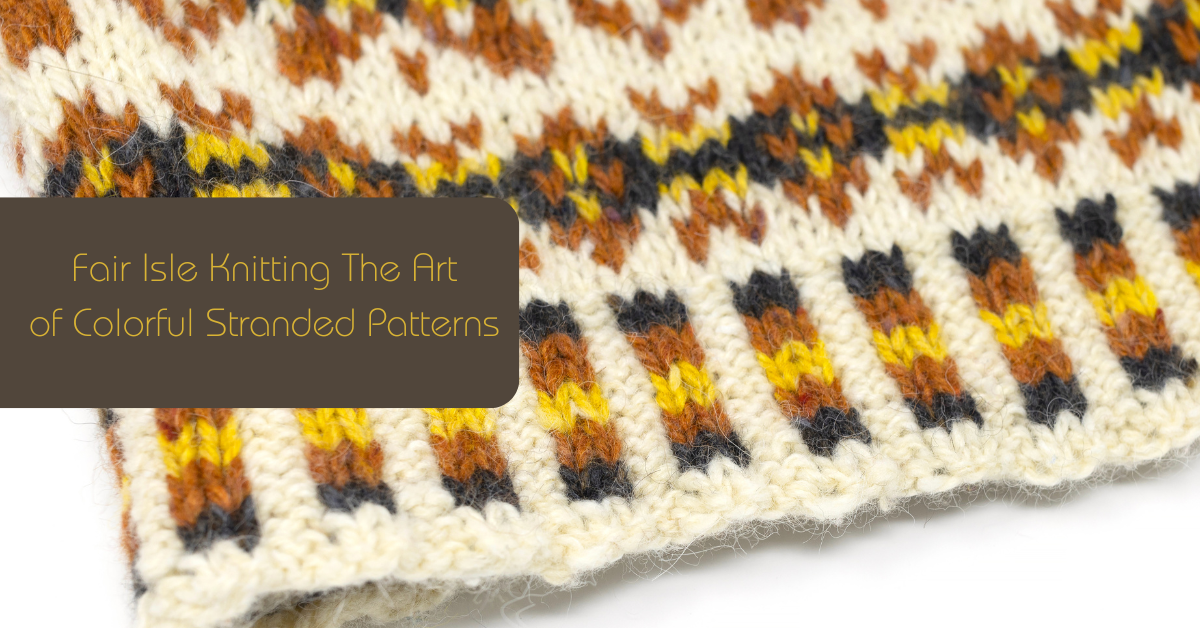Fair Isle knitting is a traditional colorwork technique that uses two or more colors per row to create intricate, repeating patterns in knitted fabric. Named after Fair Isle, one of the Shetland Islands in Scotland, this method became popular for its beautiful motifs and efficient color usage. Today, Fair Isle knitting remains a favorite among knitters who enjoy combining color and pattern in timeless, eye-catching designs.
Key Characteristics of Fair Isle Knitting
- Stranded colorwork: Only two colors are used per row, carrying the unused yarn behind the work (called floats).
- Small repeating patterns: Typically use geometric shapes, dots, diamonds, crosses, and stars.
- Circular knitting: Most Fair Isle designs are knit in the round, especially in sweaters or hats.
- Color dominance: One color appears more prominent based on how the yarn is held.
Materials You’ll Need for Fair Isle Knitting
To get started with Fair Isle knitting, gather:
- Yarn: Choose high-contrast colors in the same weight. Shetland wool is traditional.
- Knitting needles: Circular or double-pointed needles are ideal for knitting in the round.
- Stitch markers: Help mark repeats in the pattern.
- Color chart: Graphs are typically used to follow Fair Isle motifs.
How Does Fair Isle Work?
Fair Isle knitting uses the stranded method: while knitting with one color, you “carry” the other yarn along the back of the fabric, creating floats. These floats are hidden inside the work and help form the structure of the design.
Here’s the typical process:
- Choose or create a color chart: This is a grid representing each stitch and color.
- Work in the round: This avoids the purl side, which can make colorwork more difficult.
- Strand unused yarn: Carry the yarn not in use loosely across the back of the work.
- Catch long floats: If a color is unused for more than 5 stitches, catch it midway to avoid long, loose strands.
Important Techniques in Fair Isle Knitting
1. Color Dominance
The yarn held in the dominant position (usually the left hand) appears more prominent in the pattern. Keep consistent dominance throughout your work.
2. Catching Floats
To avoid loose loops on the back of the work, twist the unused yarn into the working yarn every few stitches.
3. Even Tension
Stranded knitting can become too tight or too loose. Keep your hands relaxed and spread your stitches along the needle as you work to maintain even tension.
4. Steeking
This advanced technique is used when a circular piece needs to be cut to form openings (like cardigan fronts or armholes). Steeking involves reinforcing the fabric with crochet or sewing before cutting.
Common Fair Isle Motifs
Fair Isle motifs are often small and repetitive. Some examples include:
- Xs and Os
- Snowflakes
- Diamonds
- Zigzags
- Vertical bars
You can mix and match motifs to create your own unique design.
Tips for Success with Fair Isle
- Use high-contrast colors: This enhances pattern visibility.
- Practice with a swatch: Get familiar with holding two yarns.
- Start with a small project: Hats or headbands are perfect for beginners.
- Block your work: Gently wet-blocking your finished piece helps even out tension and define the design.
Best Projects for Fair Isle Knitting
- Hats and beanies: A classic and quick way to show off colorwork.
- Cowls and mittens: Small, portable, and great for trying new motifs.
- Sweaters and yokes: Traditional Fair Isle sweaters are heirloom-worthy projects.
- Christmas stockings: Add festive flair with bold colorwork patterns.
Fair Isle vs. Other Colorwork Techniques
| Technique | Colors per row | Float management | Typical use |
|---|---|---|---|
| Fair Isle | 2 | Stranded across back | Repeating patterns |
| Intarsia | Multiple | No floats | Large blocks of color |
| Mosaic | 1 per row | Slip stitches used | Geometric motifs |
| Double Knitting | 2 | Reversible fabric | Warm accessories |
Final Thoughts
Fair Isle knitting is a vibrant, creative, and deeply traditional technique that allows knitters to play with color and pattern. Whether you’re knitting a classic Shetland-style yoke sweater or a colorful modern cowl, the rhythmic process of stranded colorwork is both meditative and satisfying.
With just two colors per row and a little practice in managing yarn tension, you can master Fair Isle and begin incorporating its beautiful motifs into your knitting repertoire.

